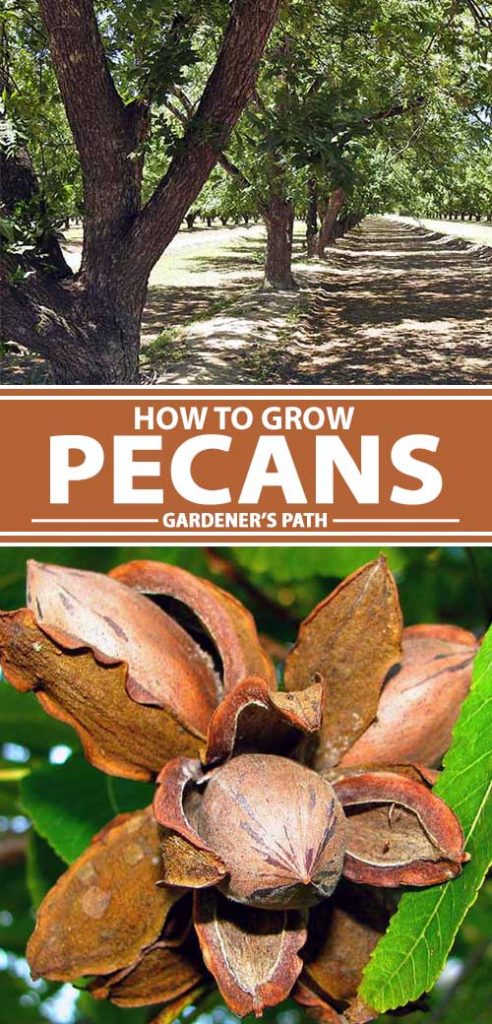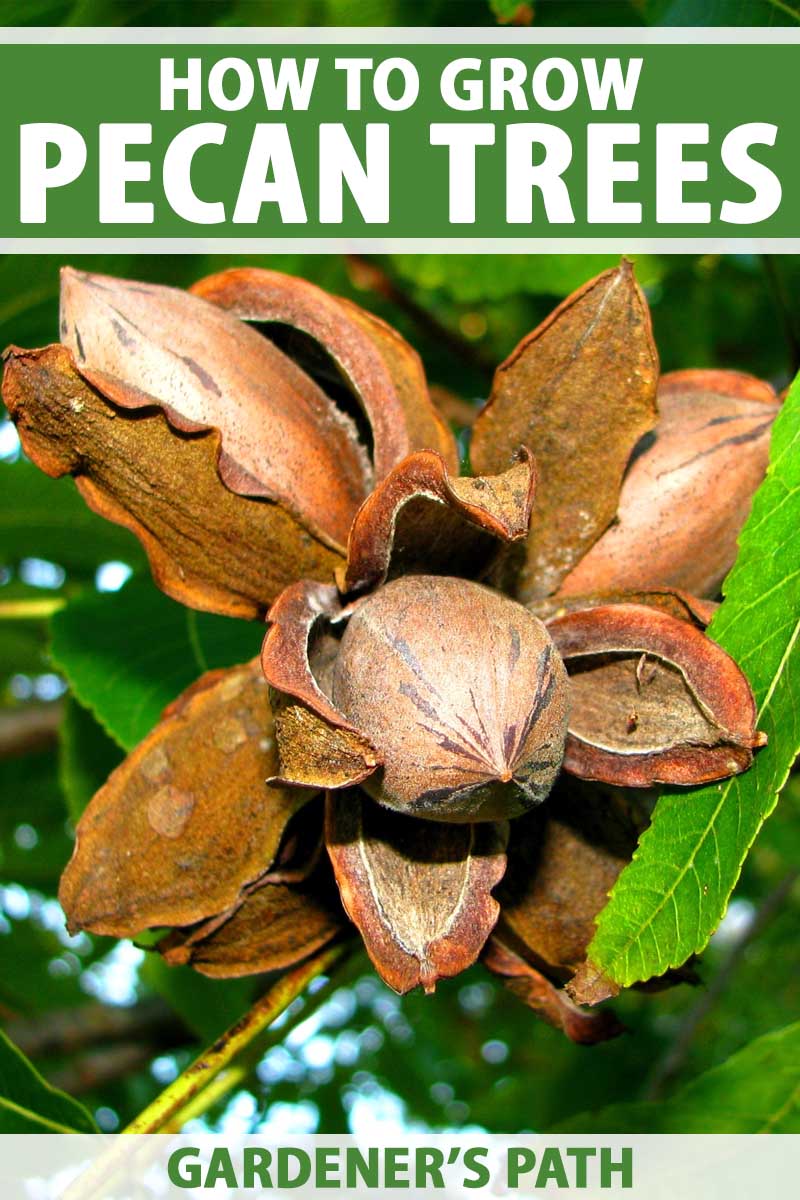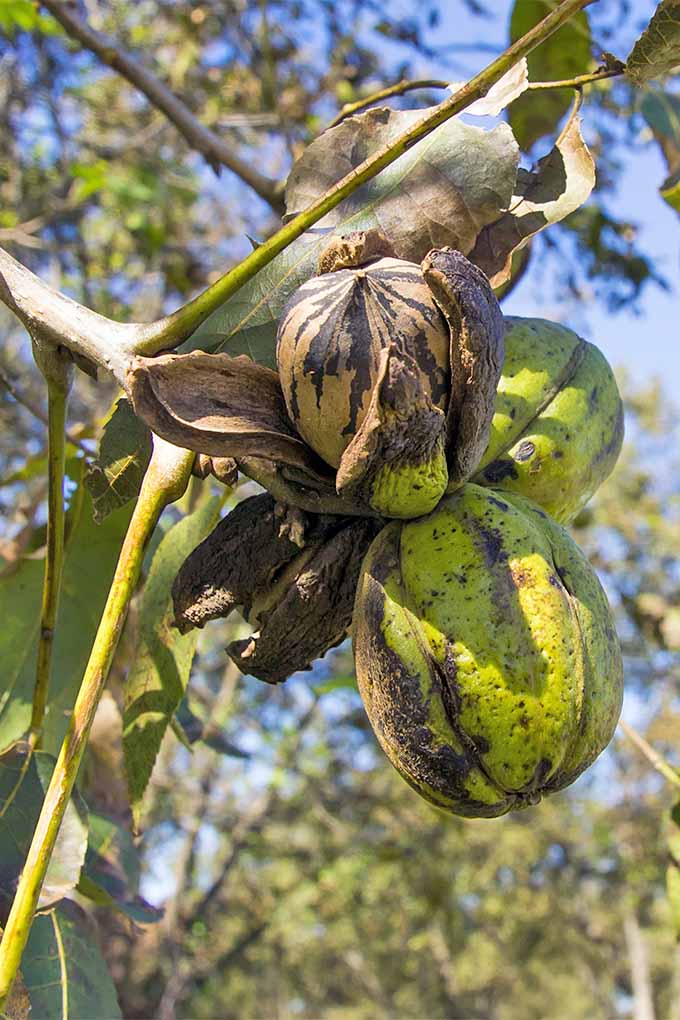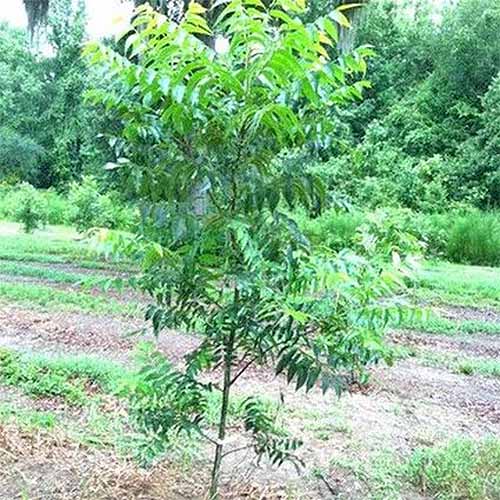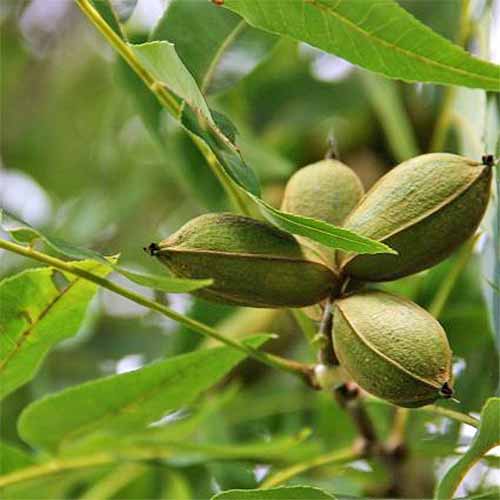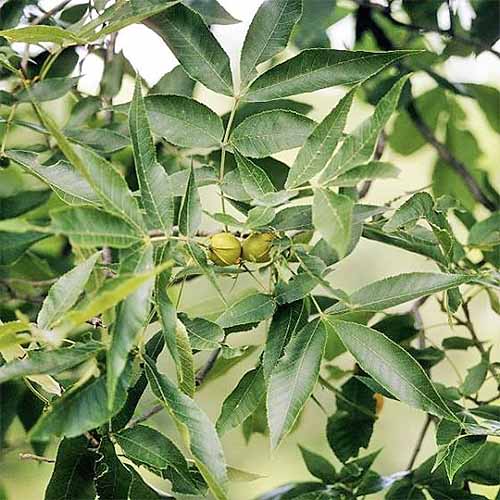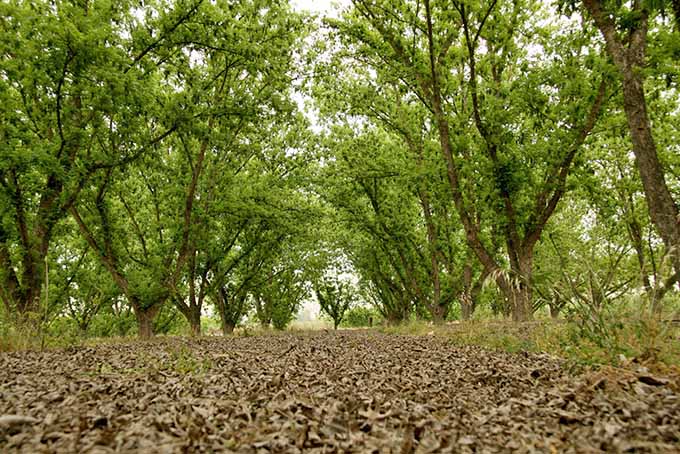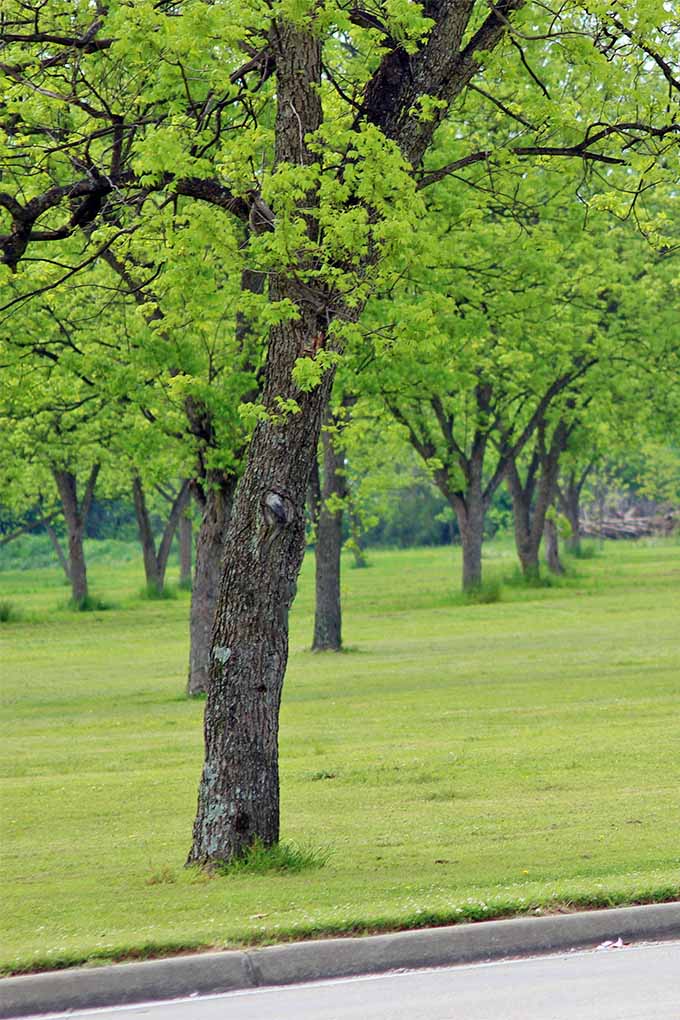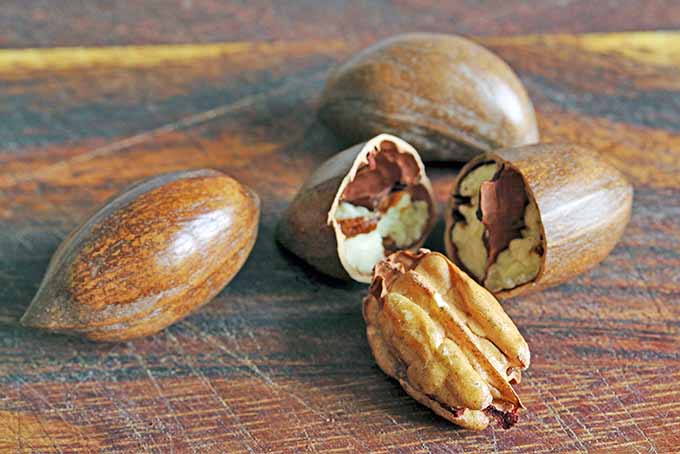Pronunciation. If you say PEE-can… you might just have to go away. Seriously, I can’t even. I’ve lived in Texas for close to 30 years, and it’s our state tree. So I get to say how it’s pronounced! Just kidding. But really. It’s puh-KAHN. We link to vendors to help you find relevant products. If you buy from one of our links, we may earn a commission. Despite its bounteous gifts, some people consider the pecan a hassle, because it’s a messy thing, what with dropping copious amounts of twigs, leaves, and fruit every fall. My San Antonio-reared husband has not-so-fond memories of being sent out in the yard as a young child to clean up after his family’s large and sloppy pecan trees. This may explain why we have close to 60 trees on our small suburban lot, but not one of them is a pecan.
That and we don’t really have room for this mammoth, which can get as large as 130 feet tall and 75 feet wide. If I had a few acres, I would love to grow this beauty. Have you seen the price of grocery-store pecans? Without further ado, here’s what’s to come, followed by our top tips so you can grow your own.
Origins and Current State
While Texas, in true narcissistic Texan form, lays claim to the tree, it is actually native to a large swath of the United States, from south of San Antonio east to southern Louisiana and north through Oklahoma, Mississippi, Tennessee, Arkansas, Kentucky, Missouri, Indiana, and Illinois. And it is now commercially grown across the southern US from sea to sea, as well as in Kansas and Missouri. A member of the hickory genus (Carya spp.), the pecan is hardy to zone 5. However, that isn’t to say that anyone located in Zones 5 and higher can necessarily grow it.
Pecans love the heat. According to William Reid, Pecan Research and Extension Specialist for Kansas and Missouri, pecans require warm summers with warm temperatures at night to ripen. So, even though an area might be in Zone 5 based on its low temperatures, that doesn’t mean the nights stay warm enough to grow pecans, according to Reid. If in doubt, consult your local county extension agent to find out whether your area has the right climate for C. illinoinensis, and to find out which variety will do best locally.
One or More?
You’ll want to choose a planting site carefully to accommodate the size of the tree. Most experts recommend purchasing a four- to eight-foot tree; this size has the best transplant success.
We’ll give you a few varieties that are known to do well in various states, but as we mentioned above, you’ll want consult your local extension office for the final word on what will do best in your area. In addition to native types, many cultivars have been developed. Reid recommends gardeners in Kansas and Missouri look for ‘Kanza,’ ‘Hark,’ or ‘Shepherd.’ Incidentally, Reid says gardeners in northern climes should stay away from trees labeled as “hardy pecan.” “It’s a marketing term,” he says. “It’s just a wild seedling from Missouri.” Gardeners should instead look for specific cultivars known to do well locally, he says. Moving further south, ‘Amling’ does well in North Carolina, and Texans have good luck with ‘Caddo.’ Mississippians should look for ‘Kiowa,’ while Georgian and Louisianan gardeners often plant ‘Elliott,’ and might want to check out this tree from FastGrowingTrees.com.
‘Elliott’ ‘Elliot’ trees #5 containers are also available from Nature Hills Nursery, and they’ll do well in Zones 6 to 9.
C. illinoinensis ‘Elliot’ If you’re located up North, ‘Pawnee’ might be for you. This cultivar has been known to grow with high yields as far north as Rhode Island, Michigan, and Washington, good for Zones 6 to 9. A bit smaller in stature, this type will grow to a mature height of 20 to 30 feet with a spread of 15 to 25 feet.
C. illinoinensis ‘Pawnee,’ available from Nature Hills ‘Candy’ is another nice variety that’s known for reaching productive maturity sooner than other cultivars, and producing ripe nuts earlier in the season. With a mature height of 50 to 70 feet and spread of 40 to 50 feet, these also grow well in Zones 6 to 9.
C. illinoinensis ‘Candy,’ available from Nature Hills Nursery Finally, ‘Desirable’ is a cultivar that’s hard to resist, and it’s been a widely planted commercial favorite since the ‘60s. This type grows quickly and it’s self pruning, so you’ll get giant clusters of large nuts faster than you might from other varieties.
C. illinoinensis ‘Desirable,’ available from Nature Hills Keep in mind that this one often reaches mature heights and spreads of 75 to 100 feet. Plant C. illinoinensis at least 30 feet from any structures, more depending on the cultivar, and in a spot that gets lots of sun. Pecans require at least three feet of well-drained soil, so rocky areas with thin soil don’t work. These trees are best able to take up critical nutrients from soil that has a pH level of 6.0 to 7.0. Pecans must be cross-pollinated (usually by the wind) to reproduce well. If there are plenty of these trees in your neighborhood, you can probably get away with planting just one. But if you are the lone area gardener growing C. illinoinensis, you might need to plant a couple to get any harvestable nuts.
Dig a hole the same depth as the root ball and two or three times as wide. Break up the dug-out soil and replace it into the hole. Water thoroughly and add a thick layer of mulch. Another important component to planting a pecan is the need to immediately cut some of it off. The general guideline is to prune the top one-third of the tree, but that number can vary. Lenny Wells, Extension Horticulture Specialist for pecans at the University of Georgia, advises that larger trees will require greater cutbacks, making the above-ground portions of the plant more manageable for limited, immature root systems. Keep in mind that this type of pruning should only be done on a dormant tree, and is often already done before sale by many nurseries.
A Thirsty Customer
Usually found along riverbanks in its native environment, the pecan likes a lot of water. Young trees need 10 to 15 gallons of water per week, whether from rainfall or from irrigation. As they mature and begin producing, they need about two inches of water per week from April to October, applied at the drip line.
Fertilization is also important for C. illinoinensis. In mid- to late March, apply four pounds of balanced fertilizer such as 10-10-10 for each inch of trunk diameter. As your plant matures, year after year, you’ll want to prune to have a central leader and just four to six lateral scaffold branches. Once the tree reaches fruiting maturity, little pruning is required.
Don’t Buy That Corn Syrup Just Yet
The fruit of a pecan is technically not a true nut, but is instead a drupe — a special type of fruit in which we sometimes eat the fruit (like peaches), whereas other times the seed inside the pit is what we’re after. Southern Ag Garden Friendly Fungicide, 8 Oz. Mix one teaspoon of Garden Friendly Fungicide into one gallon of water. Safer Brand 5110-6 Insect Killing Soap, 32 Oz. This 32-ounce bottle is ready to use. If fall webworms weave their billowy nests in your trees, send a kid with a stick out to tear out and pull down the webbing, worms, and all into a bucket of soapy water. The same goes for almonds. But, hey, call it what you like, as long as you invite me to share the desserts you make from it! Alas, don’t be promising a tasty pie with fruit from your newly planted C. illinoinensis. You’ll have to wait six to 10 years after planting before you’ll get a good crop of nuts.
And then, don’t be surprised if you get a great crop one year, followed by a small or nonexistent crop the next year. If a pecan senses drought conditions one autumn, it will “turn off” nut production for the following year. This is how it evolved to deal with stressful situations. Pecans are ready to eat when the husks crack open. Most folks just pick up the nuts after they’ve fallen to the ground, though do you want to get to them before they rot, or before local wildlife get to them. The nuts are generally ready for harvest in October or November, and a mature tree will produce 40 to 50 pounds of nuts per year.
The Kitchen Calls
You’ve babied and loved on your pecan for years, and it’s finally time to taste the fruit of your labors! (In the meantime, let’s imagine all of the great things you’re going to be able to enjoy…) How about starting with a cheese ball from Vintage Kitty? This mouthwatering appetizer features butter-roasted apple chips and rosemary, in addition to toasted pecans.
Snackers might want to whip up a batch of granola with this recipe from our sister site, Foodal, which calls for a tasty blend of pecans, oats, seeds, and dried fruit. This spinach salad from Our Perfect Palette includes the satisfying crunch of pecans, along with strawberries and a poppyseed dressing. For dessert, consider a bourbon pecan pie with a chocolate crust from Hunger Thirst Play. A couple tablespoons of Kentucky’s favorite liquor gives this treat a rich and deep flavor. Or, keep things simple with this recipe for easy homemade candied pecans from Feast in Thyme.
It’s Why We Reproduce, Isn’t It?
Pecan trees can be a bit of a chore, what with the initial pruning and the wait for maturity. But if you have kids, you can just send them out to pick up the nuts and rake the leaves, so there’s that, at least.
The pecan nut the star of many classic dishes, and a tasty addition to many more. Especially those traditionally eaten in the fall, when the large, stately tree shares its bounty with us.
